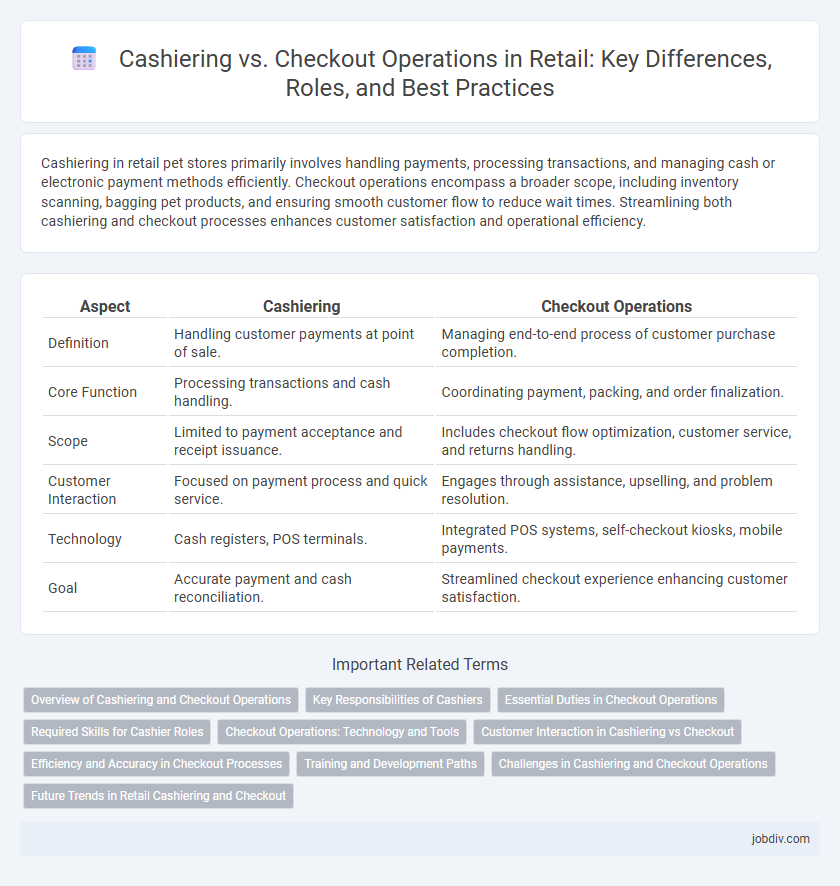Cashiering in retail pet stores primarily involves handling payments, processing transactions, and managing cash or electronic payment methods efficiently. Checkout operations encompass a broader scope, including inventory scanning, bagging pet products, and ensuring smooth customer flow to reduce wait times. Streamlining both cashiering and checkout processes enhances customer satisfaction and operational efficiency.
Table of Comparison
| Aspect | Cashiering | Checkout Operations |
|---|---|---|
| Definition | Handling customer payments at point of sale. | Managing end-to-end process of customer purchase completion. |
| Core Function | Processing transactions and cash handling. | Coordinating payment, packing, and order finalization. |
| Scope | Limited to payment acceptance and receipt issuance. | Includes checkout flow optimization, customer service, and returns handling. |
| Customer Interaction | Focused on payment process and quick service. | Engages through assistance, upselling, and problem resolution. |
| Technology | Cash registers, POS terminals. | Integrated POS systems, self-checkout kiosks, mobile payments. |
| Goal | Accurate payment and cash reconciliation. | Streamlined checkout experience enhancing customer satisfaction. |
Overview of Cashiering and Checkout Operations
Cashiering operations involve processing customer payments through cash registers, handling cash, credit cards, and digital payments, while ensuring accurate transaction records and providing receipts. Checkout operations encompass the entire customer experience at the point of sale, including scanning items, bagging, and addressing customer inquiries to facilitate smooth and efficient purchases. Both functions are critical for maintaining retail efficiency, enhancing customer satisfaction, and securing transaction accuracy.
Key Responsibilities of Cashiers
Cashiers are responsible for accurately scanning and processing customer purchases, handling various payment methods, and providing receipts while maintaining a high level of customer service. They also manage cash registers, reconcile cash drawers at the end of shifts, and resolve minor customer issues related to transactions. Ensuring speedy and error-free operations directly impacts the overall efficiency of checkout processes in retail environments.
Essential Duties in Checkout Operations
Checkout operations primarily involve scanning items, processing payments, and issuing receipts to ensure efficient customer transactions. Essential duties include verifying product prices, handling various payment methods such as cash, credit cards, and mobile wallets, and managing returns or exchanges promptly. Accurate bagging and providing courteous customer service are critical to maintaining positive shopper experiences and operational flow.
Required Skills for Cashier Roles
Cashier roles in retail require strong numerical accuracy, efficient transaction processing abilities, and excellent customer service skills to handle payment methods and resolve queries seamlessly. Proficiency in point-of-sale (POS) systems and basic data entry ensures smooth checkout operations, reducing wait times and enhancing the shopping experience. Effective communication and problem-solving skills are essential to manage customer interactions and address discrepancies during checkout efficiently.
Checkout Operations: Technology and Tools
Checkout operations leverage advanced technologies such as barcode scanners, contactless payment systems, and self-checkout kiosks to streamline the retail experience and reduce customer wait times. Integration with inventory management software and real-time data analytics enhances accuracy and operational efficiency at the point of sale. These tools enable retailers to optimize workforce allocation, improve transaction speed, and deliver seamless customer service.
Customer Interaction in Cashiering vs Checkout
Cashiering involves direct customer interaction, requiring cashiers to handle payments, provide change, and address inquiries in real-time, which enhances customer satisfaction through personal engagement. Checkout operations often include self-service kiosks or automated systems that reduce human interaction but increase transaction speed and efficiency. The choice between cashiering and automated checkout impacts the overall customer experience by balancing personalized service with convenience and operational efficiency.
Efficiency and Accuracy in Checkout Processes
Cashiering and checkout operations are critical for retail efficiency and accuracy, with cashiering focusing on transaction processing and payment handling, while checkout operations encompass inventory updates and customer service. Optimizing barcode scanning technology and integrated POS systems reduces errors and speeds up transactions, enhancing overall checkout throughput. Employee training in both areas ensures accurate pricing, fraud prevention, and improved customer satisfaction.
Training and Development Paths
Cashiering training emphasizes accuracy in transaction processing, customer service skills, and cash handling techniques, ensuring efficient and error-free payment completion. Checkout operations development integrates advanced POS system proficiency, inventory management, and queue management strategies to streamline the entire customer purchase experience. Both paths require continuous skill enhancement through workshops and e-learning modules to adapt to evolving retail technologies and customer expectations.
Challenges in Cashiering and Checkout Operations
Challenges in cashiering and checkout operations include prolonged wait times due to inefficient point-of-sale (POS) systems and insufficient staff training on handling diverse payment methods. Frequent technical glitches, like barcode scanning errors and software crashes, disrupt transaction flow and frustrate customers. Managing high transaction volumes during peak hours often leads to increased errors and compromised customer service quality.
Future Trends in Retail Cashiering and Checkout
Future trends in retail cashiering and checkout emphasize automation, contactless payments, and AI-powered self-checkout systems to enhance speed and customer convenience. Integration of biometric authentication and mobile wallet technologies is driving seamless, secure transactions, reducing dependency on manual cashier roles. Retailers are investing in omnichannel solutions that unify in-store and online purchase experiences, optimizing operational efficiency and data-driven customer insights.
Cashiering vs Checkout Operations Infographic

 jobdiv.com
jobdiv.com